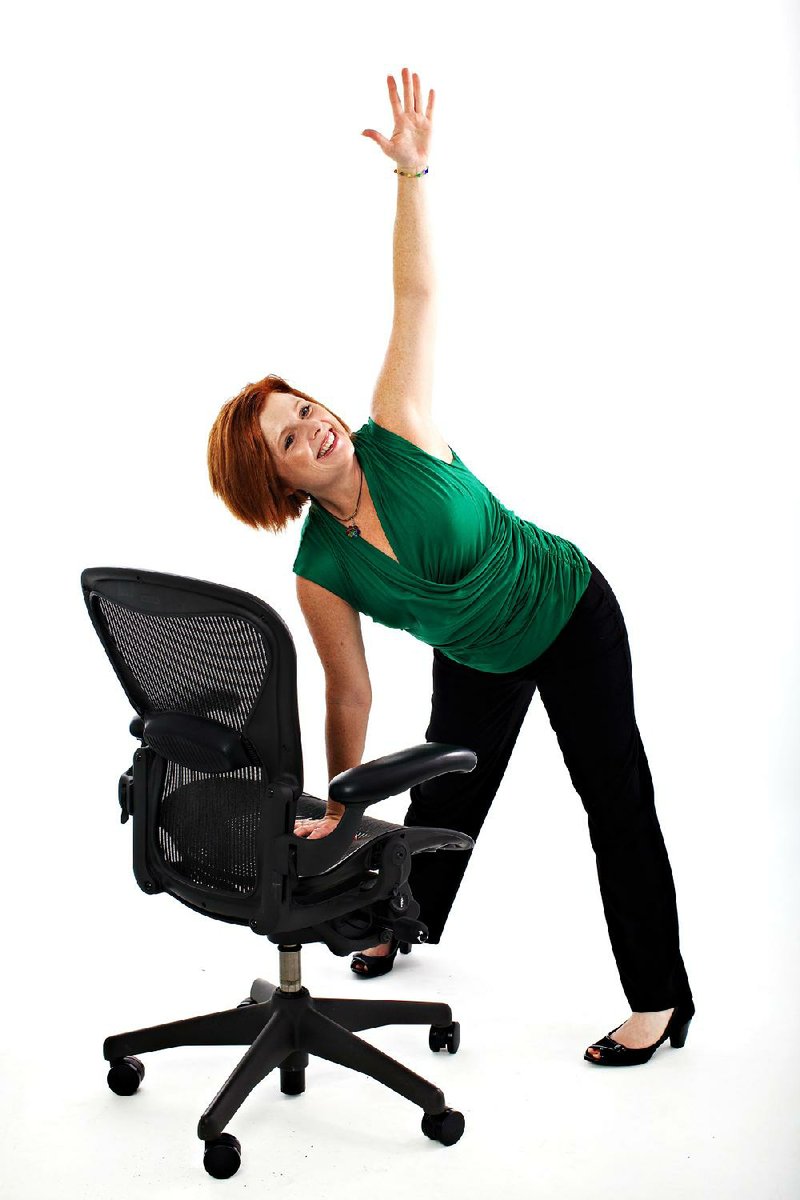LITTLE ROCK — My new office habit: When I’m feeling overwhelmed, I get as floppy as possible in my chair.
With my chest resting on my thighs, my hair brushing the tops of my feet and my knuckles touching the ground, I take a few deep breaths. I enjoy the stretch along the backs of my legs. A sense of calm overtakes me.
And when I sit back up, I’m greeted by an awesome head rush - and not a single strange look from my colleagues.
That’s because they know I’m just practicing Centered being, a mindful movement system that’s designed to fight sedentary behavior and stress. The techniques, which are adapted from yoga and Pilates, can be strung together to build a workout, but they’re also handy whenever you need a moment to focus on your body rather than your computer screen.
“Your mood can improve in 10 minutes even if your biceps don’t look different,” says Centered being co-creator Suzie Carmack.
As a group of my colleagues grabbed chairs and circled up for a workshop, Carmack warned us we wouldn’t be sitting for long. Maybe we had spent an hour at the gym that morning and maybe we hadn’t. There were still another 23 hours of the day.
“What can we do for them? I call it the movement vitamin,” Carmack said.
The Fairfax, Va., resident, who’s working on a doctorate in health communication at George Mason University, obsesses over how language can motivate or discourage people. “We’re big on using ‘movement’ instead of ‘exercise.’ Exercise is a clunky word,” she says. “And everyone has to move.”
OFFICE MANNERS
These days, however, movement often has to be within reach of a desk. Whether it’s because of responsibilities that demand constant attention or bosses who frown on afternoon strolls, it can be tough to get away. Carmack’s solution is not to fight the chair but to use it.
So she had us face our chairs, grip the sides of the seat and do pushups. (Standing in a lunge lessens the load, while picking up a leg boosts the difficulty.) We turned around to squat, and then took a seat to rotate to the right and the left, holding the stretch for several breaths.
Carmack showed us how to maneuver into Warrior 2 yoga pose while keeping our fannies on the chairs, how to extend our arms to the sides and roll our shoulders forward and backward, and how to walk our legs out from our chairs until we were supported by just our palms on the seats. That’s reverse plank, which helps counteract the effects of sitting hunched over for hours.
We ended the session by lying down with our backs on the floor and our calves resting on the chairs while listening to Carmack talk about respect, courage and kindness. Then we floated back to our desks ready to face whatever.
TIPS ON WEB
We were also ready to face the next day, armed with tips from Carmack on how to stick with her program.
The Centered being Web site (centeredbeing.com) features several 10-minute chair-based workouts. And she left us with handouts on “2/4/6/8/10,” Carmack’s numeric device that makes it easier to understand anatomy. Two through eight represent joints that need to be moved every day, and 10 is a reminder to take 10 breaths for mindfulness and to set aside 10 minutes to think about your health.
The goal is to make activity as easy and as accessible as possible, says Carmack, who co-founded Centered being with another yoga instructor, Mary Elko Comfort. Carmack had been teaching kids and wanted to develop a system that would keep them active and help them handle stress. Comfort was looking for better ways to address the needs of senior citizens.
What they developed ended up being something that could be useful for anyone - even themselves. “I want to have a two-hour restorative yoga class every day, but no way I’m doing that,” says Carmack, who has found that doctoral research on sedentarism means a whole lot of sitting. “If I’m feeling that way and I love this stuff and trained in this stuff, what does that mean for the rest of the world?”
It’s not looking good, agrees Gary Kreps, director of George Mason’s Center for Health & Risk Communication and Carmack’s adviser. But her methods give him hope, particularly the way she blends the physical and the mental. “It’s the gentler and kinder aspects of yoga. No twisting yourself into a pretzel position, or having to go to a chiropractor after,” he says. “She doesn’t frame it as technical or intimidating.”
When Kreps helped host an international health conference last year, Carmack’s Centered being breaks proved popular with attendees, who ranged in age from their 20s to their 70s. She got a similar response from faculty and staff at American University, where health promotions manager Amy Farr hired her to hold sessions. “She’s been able to meet people where they are,” Farr says. “She delivers it in small chunks, not a whole overhaul.”
BUILDING A NETWORK
Word has gradually gotten out as Carmack and Comfort have trained a national network of 150 Centered coaches over the past three years.The next step is launching the Centered being phone application, expected to debut in the iTunes store this month, filled with more video clips and a structured wellness program.
If you don’t have time to tap into these new resources, don’t stress out about it. But I do recommend trying to get floppy in your chair.
ActiveStyle, Pages 26 on 09/24/2012

